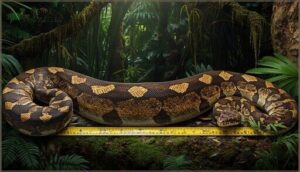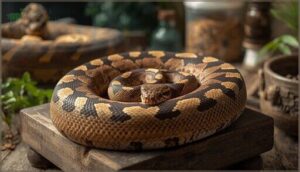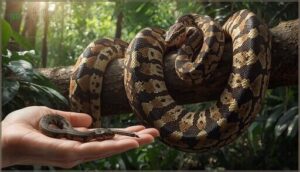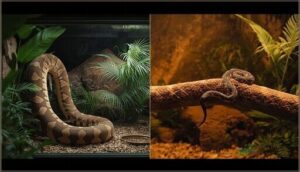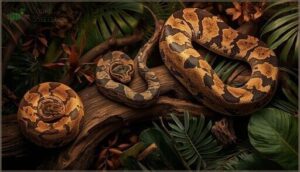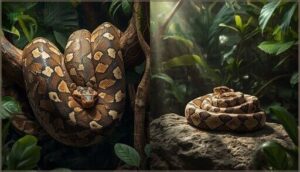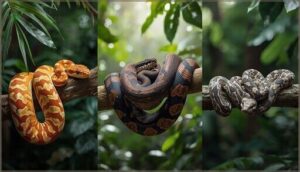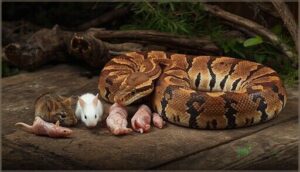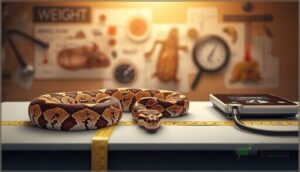This site is supported by our readers. We may earn a commission, at no cost to you, if you purchase through links.
 A female boa constrictor can stretch past 10 feet, while her male counterpart rarely exceeds 7. That gap isn’t just trivia—it shapes every decision you’ll make about housing, feeding, and long-term care.
A female boa constrictor can stretch past 10 feet, while her male counterpart rarely exceeds 7. That gap isn’t just trivia—it shapes every decision you’ll make about housing, feeding, and long-term care.
New keepers often underestimate how much space a growing boa demands, or they overfeed in hopes of accelerating growth, only to end up with an obese snake plagued by health issues.
Understanding the average size of a boa constrictor means recognizing that subspecies, genetics, diet, and environment all conspire to determine whether your snake becomes a compact 5-footer or a powerful 9-foot powerhouse. Getting the fundamentals right from day one ensures your boa reaches its genetic potential without compromising health or outgrowing your setup.
Table Of Contents
- Key Takeaways
- Average Boa Constrictor Size
- Male Vs. Female Boa Size
- Growth Rates and Patterns
- Maximum and Minimum Recorded Sizes
- Subspecies Size Variations
- Factors Affecting Boa Constrictor Size
- Nutrition and Feeding for Growth
- Health and Size Relationship
- Boa Constrictor Size Myths
- Frequently Asked Questions (FAQs)
- Conclusion
Key Takeaways
- Female boa constrictors typically reach 7–10 feet and 22–33 pounds, while males average 6–8 feet and 13–16 pounds—a size difference that directly determines your enclosure dimensions, feeding schedule, and long-term care requirements.
- Growth happens fastest in the first three years (often tripling birth length), then dramatically slows after sexual maturity, with adults adding only 2–6 inches annually, so your housing and feeding plans need to account for this rapid early expansion.
- Subspecies genetics create enormous variation, from dwarf Tarahumara mountain boas capping at 4.5 feet to mainland specimens exceeding 10 feet, meaning you must research your specific boa’s lineage to predict its adult size accurately.
- Weekly feeding at 10% body mass, proper temperature gradients (90–95°F warm side), and adequate enclosure space (minimum 6’L × 3’W × 3’H for adults) are non-negotiable factors that determine whether your boa reaches its genetic potential or suffers stunted growth and health complications.
Average Boa Constrictor Size
If you’re thinking about bringing a boa constrictor into your life, you’ll want to know what you’re signing up for regarding size. These snakes aren’t small, but they’re not the giants some people imagine either.
Let’s break down the typical measurements you can expect, from hatchling to full-grown adult.
Typical Length Range
When you’re looking at boa constrictor size, most adults measure between 6 and 10 feet—a reliable baseline for planning care. Females usually stretch 7 to 10 feet, while males average 6 to 8 feet. Though outstanding specimens reach 13 feet, lengths beyond 11 feet remain uncommon.
- Average length spans 6–10 feet across most populations
- Constrictor measurements show females consistently outsize males
- Maximum recorded length hits 13 feet in rare cases
- Boa dimensions vary by subspecies and locality
- Growth rates stabilize once snakes reach typical adult size
Understanding the boa’s tropical rainforest habitat is vital for their care.
Average Weight Range
Adult boa constrictors usually weigh 22 to 33 pounds for females and 13 to 16 pounds for males—weight factors you’ll need when setting up your feeding schedule. Some large specimens reach 60 pounds, while unusually large individuals may hit 100 pounds. Most captive adults settle around 25 to 30 pounds, with size variance driven by sex, subspecies, and nutrition impact on growth rate.
Understanding their muscular body types is vital for providing proper care and housing.
Size at Birth Vs. Adulthood
Neonate development starts dramatically—your baby boa arrives at 15 to 24 inches and weighs just 2 to 3 ounces. That’s quite the boa constrictor size comparison against a 7 to 10-foot adult averaging 22 to 60 pounds.
Growth patterns reveal the size increase happens fast:
- Birth weight doubles within weeks
- Length triples during year one
- Growth rate peaks before year three
- Maturity rates stabilize at 6 to 8 feet
Snake size transforms rapidly during early life.
Male Vs. Female Boa Size
When you’re planning for a boa constrictor, understanding the size difference between males and females isn’t just interesting—it’s essential for proper care. Female boas consistently outgrow their male counterparts, sometimes by several feet, which directly impacts your enclosure needs and handling approach.
Let’s break down exactly how the sexes differ and what that means for you as a keeper.
Growth Differences by Sex
When you’re tracking your boa’s development, you’ll notice females surge ahead dramatically. Sexual dimorphism drives distinct growth rate patterns—females accumulate length and mass faster, especially during the first four years. Males plateau around year three, while females maintain steady gains much longer. This size dimorphism evolution reflects reproductive advantages, as larger females produce bigger litters.
| Growth Factor | Females | Males |
|---|---|---|
| Annual Growth Rate | Higher, sustained longer | Slower, plateaus earlier |
| Growth Duration | Continues 4+ years | Slows after 3 years |
| Size at Maturity | 7-10 feet, 25-30 lbs | 5-8 feet, 13-16 lbs |
Size Comparisons and Examples
You can visualize the difference by comparing your adult female to a male—she’s often a full two feet longer and twice his weight. A mature female usually reaches 9 feet and hovers near 30 pounds, while her male counterpart caps out around 7 feet and 15 pounds. These length records and weight factors illustrate clear size variance across growth stages and body proportions.
| Measurement | Adult Female | Adult Male |
|---|---|---|
| Average Length | 7-10 feet | 5-8 feet |
| Typical Weight | 22-33 lbs | 13-16 lbs |
| Maximum Documented | 12+ feet | 8-9 feet |
| Growth Duration | 4+ years | ~3 years |
Growth Rates and Patterns
Understanding how fast your boa constrictor grows helps you plan for housing upgrades and feeding schedules. These snakes don’t grow at a steady pace—they experience rapid spurts early on, then gradually slow down as they approach adult size.
Let’s break down what you can expect year by year and when growth usually levels off.
Annual Growth Progression
Your boa constrictor’s growth rate follows a predictable arc that you’ll want to understand from day one. During the first year, your snake will nearly double or triple in length—from around 15–20 inches at birth to roughly 29 inches by year’s end. This explosive phase represents the steepest growth apex you’ll witness.
Here’s how annual growth progression usually unfolds:
- Years 1–3: Rapid expansion continues, with boas reaching 35–47 inches by year two and 6–10 feet by year six
- Years 3–6: Sexual maturity arrives around year three, triggering a noticeable slowdown in annual growth increments
- Years 6+: Growth rate drastically declines, with adults adding only 12–16 inches over the next decade
Feeding impact shapes these patterns considerably. Weekly smaller meals promote faster growth than biweekly larger feedings, directly affecting how quickly your boa reaches its genetic potential. Favorable temperatures matter too—favorable temperatures foster food conversion to body mass, while substandard husbandry effects can permanently limit final size.
Understanding these boa constrictor growth patterns helps you calibrate expectations and adjust care protocols as your snake matures through distinct developmental phases.
Growth Spurts and Plateaus
When do explosive spurts give way to plateaus in boa constrictor growth patterns? Your snake’s early growth velocity peaks during the first 3–6 years, often adding 12–24 inches annually. Feeding regime impact matters considerably—weekly meals accelerate gains.
After sexual maturity, plateau phase triggers kick in, slashing annual increments to just 2–6 inches. Subspecies genetic influence and environmental growth factors ultimately determine whether boas reach their full potential or stall prematurely.
Maximum and Minimum Recorded Sizes
Regarding boa constrictors, size can vary dramatically from one end of the spectrum to the other. You’ll find record-breaking giants that push the boundaries of what we expect from these snakes, alongside dwarf subspecies that stay surprisingly compact throughout their lives.
Let’s look at both extremes to give you a complete picture of what’s possible.
Largest Documented Boa Constrictors
You might be surprised to learn that Fluffy, the world’s longest documented boa, measured an astounding 24 feet—twice the typical maximum length. Record confirmation remains important, as misidentification issues with anacondas have inflated some claims.
In captivity, giants like Felix reached 210 pounds, showcasing extreme weight variations. Wild maximums rarely exceed 13 feet, with factors influencing boa size including genetics and nutrition shaping body size potential.
Dwarf and Smaller Subspecies
At the opposite end of the spectrum, you’ll find dwarf boas that challenge everything you thought you knew about size genetics. Tarahumara mountain boas reach just 3.5 to 4.5 feet at adulthood—island dwarfism and high-elevation dwarf boa habitats drive these subspecies size variations.
Mini-boa care requirements differ considerably, with boa constrictor subspecies like Boa constrictor ortonii demonstrating how captive growth rarely exceeds five feet, even under ideal conditions.
Subspecies Size Variations
Not all boa constrictors grow to the same size—your snake’s subspecies matters more than you might think. Different populations have adapted to their native habitats over thousands of years, resulting in measurable size differences across regions.
Understanding these variations helps you predict your boa’s adult dimensions and plan appropriate housing from the start.
Size Differences Among Subspecies
Not all boa constrictor subspecies grow to the same size—that’s where understanding subspecies size variations becomes essential. Boa constrictor constrictor generally reaches 7 to 10 feet, while Boa constrictor imperator shows an imperator length range of 4 to 8 feet. Argentine boa size averages 8 to 10 feet for females. Dwarf boa size rarely exceeds 5 feet. Subspecies weight differences reflect these length patterns accordingly.
Notable Geographic Variations
Island dwarfism shapes Caribbean boas and island populations dramatically—Hog Island specimens mature at just 4 to 5 feet, while Amazonian giants from eastern South America regularly exceed 10 feet. Central variations in Boa imperator average 5 to 7 feet.
These size differences stem from ecological drivers like prey availability and environmental conditions, not random chance. Geography determines your boa constrictor’s final potential.
Factors Affecting Boa Constrictor Size
Your boa’s final size isn’t written in stone from the moment it hatches. Several key factors work together to determine whether your snake reaches its full potential or stays on the smaller side.
Let’s look at the main influences that shape how big your boa constrictor will actually grow.
Genetic Influences
Your boa constrictor’s genes are the blueprint for its adult size. Dwarfism genes and inherited traits from both parents determine maximum potential length—some Central American boas with locale-specific dwarf genes top out at just 3–5 feet, while mainland specimens routinely exceed 8 feet.
Subspecies divergence, genetic drift, and size variations mean breeding lines matter. The Leopard morph, for instance, averages only 5 feet due to recessive genetic factors affecting growth.
Diet and Nutrition Impact
Feeding frequency and prey size dramatically shape your boa’s growth rate and final dimensions. Weekly meals at 10% body mass produce longer, more substantial snakes than infrequent large feedings—even with equal calories.
Malnutrition effects include stunted length (up to 30% shorter), weakened immune response, and skeletal fragility. Suitable nutrition means appropriately sized rodents delivered consistently, supporting muscle development while avoiding obesity from overfeeding high-fat prey.
Environmental and Housing Factors
Beyond what you feed your boa, where it lives matters just as much. Enclosure size directly influences growth—undersized housing restricts movement and stunts development.
Your thermal gradient (90–95°F warm side, 75–80°F cool) and humidity levels (50% baseline, 70% during sheds) regulate metabolism.
Environmental enrichment like climbing branches and hiding spots reduces stress, supporting healthy growth patterns throughout your snake’s life.
Nutrition and Feeding for Growth
What you feed your boa constrictor directly shapes how large and healthy it will grow. Getting the diet right means understanding what prey items support peak development and how often to offer them.
Let’s break down the nutritional approach that helps your boa reach its full genetic potential.
Ideal Diet for Optimal Size
Your boa’s nutrition directly shapes its adult size and overall health. Think of diet as the blueprint for growth—every meal matters. To get the most out of size potential, focus on whole prey that delivers complete nutritional value:
- Appropriately sized rodents (rats, mice) form the dietary foundation
- Occasional birds or rabbits add beneficial variety and nutrient diversity
- Calcium and vitamin D3 supplementation prevents metabolic bone disease in captivity
- Fresh water availability helps digestion and hydration during all life stages
- Temperature-optimized feeding environments improve digestive efficiency and nutrient absorption
Wild diet variety teaches us that nutritional breadth—not monotony—fuels ideal growth.
Feeding Frequency and Prey Size
Timing isn’t just habit—it’s biology. Your feeding frequency and prey size directly influence growth trajectory, body composition, and long-term health. Here’s what works:
| Life Stage | Feeding Interval | Prey Size (% Body Weight) |
|---|---|---|
| Neonate ( When it comes to boa constrictors, adequate enclosure space isn’t a luxury—it’s a biological necessity for proper growth and development |
Health and Size Relationship
Your boa’s size tells you a lot about its overall health—too big or too small can signal problems that need attention. Obesity puts strain on internal organs, while stunted growth often points to dietary gaps or environmental stress.
Let’s look at how to prevent these extremes and recognize the health issues that show up when size goes off track.
Preventing Obesity and Undersized Growth
Keeping your boa at a healthy weight requires smart feeding, regular body evaluations, and attention to exercise needs. Obesity and stunted growth both stem from imbalances in feeding frequency, portion control, and nutrition. Weekly checks for fat rolls or visible spine are essential; adjust prey size and feeding schedule accordingly. Supplementation risks should not be overlooked—too much can be as harmful as too little.
| Body Condition | What to Look For | Action Steps |
|---|---|---|
| Healthy | Firm body, smooth scales, no visible spine | Maintain current feeding frequency and prey size |
| Underweight | Triangular shape, visible spine, thin girth | Increase meal size slightly; feed more frequently |
| Overweight | Rounded body, fat rolls, squishy texture | Reduce feeding frequency to every 14 days; smaller prey |
| Obesity Warning | Thick girth near head, segmented appearance | Vet consultation; increase exercise; cut feeding frequency |
| Growth Plateau | No size change over 3+ months (juveniles) | Review temperature gradient and prey nutrition quality |
Common Health Issues Linked to Size
Your boa’s size directly impacts its vulnerability to disease. When weight veers off track—in either direction—trouble follows. Here’s what you need to watch for:
- Obesity complications like hepatic lipidosis destroy liver function and shorten lifespan
- Inclusion Body Disease affects up to 34% of captive boas, causing weight loss and neurological damage
- Respiratory infections strike underweight and overweight snakes with labored breathing
- Digestive disorders and impaction from overfeeding or improper prey size
- Bone disease from calcium imbalances during rapid growth spurts
Preventing obesity starts with portion control and body condition monitoring.
Boa Constrictor Size Myths
You’ve probably heard wild stories about boa constrictors growing to monstrous lengths or staying tiny in small tanks. These myths can lead you down the wrong path when preparing for your snake’s future size.
Let’s clear up the most common misconceptions so you can plan properly and avoid the mistakes that trip up new boa owners.
Misconceptions About Maximum Size
How do exaggerated weights and maximum recorded length claims gain so much traction? Anaconda confusion tops the list—many reports mistakenly identify green anacondas as boas, inflating owner expectations dramatically.
Anecdotal evidence and media influence perpetuate common myths about boa constrictors, suggesting they’ll reach 18 feet when verified specimens rarely exceed 13.
Factors impacting boa size get overshadowed by sensational stories that misrepresent actual boa constrictor size potential.
Common Beginner Mistakes
Misinformation leads directly to poor boa constrictor care. Here’s what beginner snake ownership often gets wrong:
- Enclosure Size: Housing your boa in a cage shorter than its body length restricts movement and stresses the animal—aim for at least 6’L x 3’W x 3’H for adults.
- Feeding Practices: Overfeeding boa constrictors causes obesity; juveniles thrive on 10% body mass weekly.
- Quarantine Neglect: Skipping 8–12 week isolation invites parasites and disease.
Temperature control and group housing mistakes also stunt growth.
Frequently Asked Questions (FAQs)
How does temperature affect boa constrictor growth rate?
Temperature directly impacts your boa’s growth rate through metabolic processes. Ideal temperatures between 80-85°F boost digestion efficiency and nutrient absorption, while suboptimal environmental conditions slow metabolism, impair digestion efficiency, and greatly hinder development through compromised thermoregulation behavior.
Can boas stop growing if stressed or mishandled?
Yes, chronic stress and poor handling can severely stunt your boa’s growth rate. Environmental stressors trigger hormonal imbalances that suppress growth, causing long-term health issues. Proper care ensures growth recovery and healthy development.
Do boa constrictors grow throughout their entire lifespan?
Here’s the straight truth: boa constrictors don’t stop growing entirely. They show continuous growth throughout their lifespan, though growth rate slows dramatically after maturity—often just inches yearly.
Snake growth myths aside, slow growth persists indefinitely.
What age do boas reach their full size?
Most boas reach their full size between 3 and 5 years old, though growth patterns vary by genetics, diet, and environment.
Growth slows considerably after age 4, with sexual maturity often preceding complete size development.
How do captive boas compare to wild boas?
Captive boas often grow larger than wild ones, reaching up to 14 feet compared to around 13 feet. Regular feeding and ideal conditions drive this size difference, while environmental stressors limit growth in natural habitats.
Conclusion
Your boa won’t morph into a jungle anaconda overnight, but ignoring the average size of a boa constrictor sets you up for cramped enclosures and nutrition missteps.
Whether you’re housing a petite male or a hefty female, matching diet, space, and care to their genetic blueprint keeps them thriving.
Measure twice, feed wisely, and give them room to stretch—because a boa at its healthiest size is a boa that lives longer, stronger, and happier.
- https://emaarakvaryum.com/en/boa-constrictor/
- https://wildlife-animal-pedia.fandom.com/wiki/Boa_Constrictor
- https://nationalzoo.si.edu/animals/boa-constrictor
- https://www.nationalgeographic.com/animals/reptiles/facts/boa-constrictor
- https://www.emilygweigelphd.com/wp-content/uploads/Zoo-Biology-2018-Hill-Growth-rates-of-juvenile-Boa-constrictor-under-two-feeding-regimes.pdf

